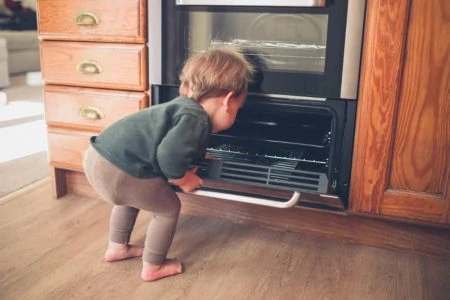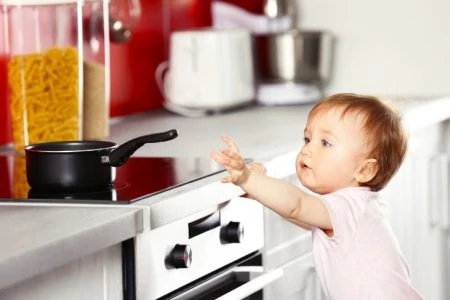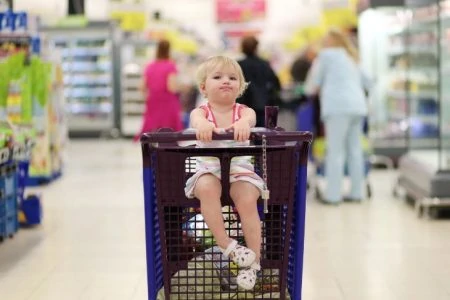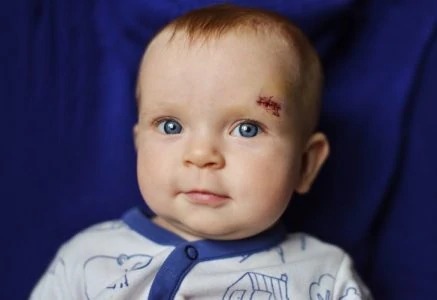The kitchen is the heart of the home, but for a curious toddler, it is also a minefield. From scalding stoves to toxic cleaning supplies, this room holds more potential hazards than anywhere else in the house.
Don’t panic. We have babyproofed countless kitchens and consulted safety experts to bring you the best tips. With a few adjustments and the right gear, you can cook dinner without constantly looking over your shoulder.
In this guide, we will break down how to secure your oven, refrigerator, cabinets, and more. We will also review essential babyproofing products to help you decide what is worth your money. Let’s make your kitchen safe for your little sous-chef.
Key Takeaways
- Secure heavy appliances and furniture to the wall to prevent tip-overs.
- Install latches or magnetic locks on all cabinets and drawers containing hazardous items.
- Use stove knob covers and guards to prevent burns and gas leaks.
- Store dangerous items like cleaning supplies and sharp objects in high, unreachable cabinets.
How to Babyproof the Stovetop and Oven
Ovens and stovetops pose the highest risk for severe injury. Burns are a leading cause of childhood emergency room visits, and kitchens are the primary location for these accidents (1).
Whether you have a gas range or an electric cooktop, follow these five steps to keep the heat at bay.
1. Never Leave the Stove Unattended
The golden rule of kitchen safety is simple: never turn your back on an active stove. A curious hand can reach a hot burner in a split second.
Once your baby starts crawling or walking, containment is key. If you cannot supervise them directly, use a safety gate to keep them out of the kitchen entirely while you cook.
For older toddlers who want to help, a designated “safe spot” works wonders. We recommend a kitchen tower (or helper stool). These enclosed steps allow children to reach counter height safely so they can watch or help with safe tasks away from the heat.
Here are a few sturdy options we recommend:
Pot handles should always be turned inward, not protruding outward from the stove. I had a 9-month-old patient in my practice who quickly got away from his parent while in a walker (a very dangerous item that we do not recommend) only to catch the handle of a pot on the stove. The pot of hot soup spilled onto him, resulting in third-degree burns on over 60% of his body and requiring several weeks of care in a burn unit.
Editor's Note:
Dr. Leah Alexander, MD, FAAP2. Get an Oven Lock
As soon as your baby can pull up to stand, the oven handle becomes a prime target. A child hanging on the door can tip the range over or be hit by the heavy door itself.
If your oven is within reach, install an oven lock immediately. This simple device prevents the door from opening and is crucial for keeping little hands away from the hot interior.
3. Remove Your Stove Knobs

Toddlers love to mimic their parents, and turning knobs is a fun game for them. Unfortunately, this can turn on a gas burner or heat up an electric coil instantly.
The cheapest solution is to pull the knobs off when you aren’t cooking. Store them in a basket on a high shelf.
If removing them daily feels like a chore, invest in clear stove knob covers. They spin freely without engaging the burner, keeping your curious climber safe.
4. Get a Stove Guard
If your child is a “climber” or is tall for their age, they might reach the burners even without touching the knobs. A stove guard creates a physical barrier between your child and the heat.
These guards attach to the front or top of your range. They prevent pots from being pulled off and keep little fingers away from open flames or hot coils.
These are the stove guards we trust:
- Prince Lionheart Stove Guard
- Safelon Stove Gas Knob Covers & Childproof Oven Lock
- Qdos Aluminum Stove Guard
With a guard in place, you gain a few precious seconds of reaction time if your child rushes the stove.
5. Cook on the Back Burners
Develop the habit of using only the rear burners. This keeps boiling pots and sizzling pans further away from the edge of the counter.
When you must use the front burners, turn the pot handles inward. A handle sticking out over the edge is tempting for a child to grab, which can result in severe scalds from hot food spilling down.
Parents should also avoid carrying hot liquids, such as cups of hot coffee or tea, when holding their child. I have seen quite a few splash burns on infants and toddlers who reached for the cup or moved too quickly, resulting in spillage of the hot liquid onto them. The AAP has more to say on this subject.
Editor's Note:
Dr. Leah Alexander, MD, FAAPHow to Babyproof the Refrigerator
You might think the fridge is safe, but it poses unique risks. Heavy doors can pinch fingers, glass jars can break, and magnets can be swallowed.
Plus, a determined toddler can use the shelves as a ladder, risking a tip-over. Here is how to lock it down.
1. Lock It

If your toddler treats the fridge like a playground, you need a lock. A simple latch lock placed high out of reach prevents them from opening the door.
For standard fridge usage, a strap lock works well. If you have a secondary fridge or freezer in the garage storing medication or alcohol, consider a heavy-duty padlock style.
2. Rearrange the Contents
Assume your child will eventually get the door open. Move heavy glass jars, alcohol, and raw meat to the top shelves.
Dedicate the bottom drawers to safe, kid-friendly items like yogurt pouches or cheese sticks. This minimizes the mess and danger if they do sneak in.
3. Remove Small Magnets
Refrigerator magnets are classic kitchen decor, but small ones are a major choking hazard. High-powered rare-earth magnets are especially dangerous if swallowed, as they can pinch intestines together.
Remove small magnets entirely. If you want to use magnets, opt for large, flat versions that cannot fit in a child’s mouth.
4. Secure It to the Wall
Refrigerators are top-heavy. If a child opens the door and climbs on the bottom shelf, the weight shift can cause the entire appliance to tip over.
Use furniture straps or L-brackets to anchor the fridge to the studs in the wall behind it. This is a critical step often overlooked by parents.
5. Lock the Water Dispenser
Water dispensers are irresistible water parks for toddlers. Check your fridge manual for a “lock” button on the interface. This usually disables the water and ice levers.
If yours lacks this feature, cover the sensors with a piece of cardboard taped over the area, or engage the “child lock” switch found inside the door frame of some older models.
Babyproofing Kitchen Cabinets and Drawers
Your cabinets and drawers are likely home to chemicals, glass, and sharp tools. Securing these is non-negotiable.
We tested the five most popular locking mechanisms to help you choose the right one for your home.
1. Magnetic Locks
Magnetic locks are the gold standard for aesthetics and security. They are invisible from the outside and very difficult for toddlers to defeat.
You install a latch inside the cabinet door, and it only opens when you wave a magnetic “key” over the outside.
**Pro Tip:** Stick the key high up on your fridge so you never lose it.
2. Spring-Latch Locks
These are the classic plastic hooks you press down to release. They are affordable and effective, but they do allow the cabinet to open about an inch.
This gap can be a pinch hazard for little fingers. However, they are great for drawers where you want quick access without hunting for a key.
3. Sliding Cabinet Locks
Sliding locks (or pull-cord locks) are perfect for mushroom-shaped knobs or D-shaped handles that sit side-by-side.
They require no installation or drilling. You simply loop the lock around the handles and tighten it. They are great for grandparents’ houses or rentals since they leave no marks.
4. Adhesive Strap Locks
If you have flat cabinets without handles, adhesive straps are a versatile solution.
One end sticks to the door, the other to the frame. They are visible and can be an eyesore, but they work on almost any surface, including trash cans and toilets.
5. Tension Rods
For a quick, drill-free hack on a stack of drawers with vertical handles, use a tension rod.
Slip the rod through all the handles from top to bottom and expand it until it is tight. This locks all the drawers at once.
How to Babyproof Your Dishwasher
1. Keep It Locked
Dishwashers are fascinating to toddlers because of the buttons and lights. Always keep the door latched when not in use. If your model has a control lock feature, engage it to stop them from starting a cycle.
2. Load Knives Point Down
The utensil basket is usually at the bottom, right at toddler eye level. If a child falls onto an open door, upward-facing knives can be fatal.
Always load knives and forks with the sharp points facing down. Better yet, lay sharp knives flat in the top rack or wash them by hand immediately.
3. Detergent Safety
Dishwasher pods are colorful and squishy, looking dangerously like candy or teething toys. However, they contain highly concentrated chemicals that cause severe burns if bitten.
Never leave a pod in the dispenser “for later.” Add the detergent right before you start the wash. Store the container in a high, locked cabinet.
4. Cover the Controls
If your toddler constantly interrupts the wash cycle by pressing buttons, create a DIY shield.
A piece of stiff cardboard or plastic taped over the top of the controls can deter button pushers. For a cleaner look, you can buy specific button covers online.
5. Check for Safety Latches
Many modern dishwashers have a mechanical safety latch. Check the top or side of the door frame for a small lever that locks the door physically, not just electronically.
Remember
How to Babyproof Your Kitchen Table
The kitchen table is a gathering spot, but it has risks regarding falls and head injuries.
1. Corner Guards

Toddlers are wobbly walkers and often bang their heads on table edges. Soft, foam corner guards cushion the blow and prevent nasty cuts.
2. Ditch the Tablecloth
Tablecloths are a huge hazard. A crawling baby can grab the hanging fabric to pull themselves up, bringing hot food, heavy dishes, and cutlery crashing down on their head.
Switch to placemats or use a fitted table protector that wraps around the edge and cannot be pulled.
3. Chair Locks

Kitchen chairs are portable ladders for adventurous kids. If your child pushes chairs to the counters to climb up, you need to secure them.
Use bungee cords or specialized chair locks to strap the chairs to the table leg or to each other when not in use.
Locking chairs can prevent curious toddlers and older children from using them as “ladders.” Most toddlers learn to climb by the age of 15 months old. They quickly realize that they can access shelves, cabinets, and other hard-to-reach items if they move step stools or similar objects into place. I have seen quite a few toddlers climb to the top of a bookshelf, risking injury from falling.
Editor's Note:
Dr. Leah Alexander, MD, FAAPA Few Extra Tips
We have covered the big appliances, but do not overlook these hidden hazards.
- Trash Can: Kitchen trash often contains raw meat packaging, sharp can lids, and choking hazards. Use a trash can with a locking lid or keep it inside a locked cabinet.
- Small Appliances: Unplug toasters, blenders, and coffee makers when not in use. Tuck the cords away. A dangling cord is a temptation for a child to pull the heavy appliance down onto themselves.
- Pet Food: Dry kibble is a major choking hazard. Water bowls can be a drowning risk for crawling infants or a slip hazard for walkers. Feed pets in a separate room or pick up bowls immediately after mealtime.
- Garbage Disposal: This is terrifyingly dangerous. Install a switch cover so your child cannot accidentally turn it on while playing.
- Plastic Bags: Grocery bags are suffocation hazards. Store them in a dispenser mounted high on a wall or inside a locked pantry, never loose under the sink.
Cooking With Your Kids
The ultimate goal is to teach your children how to be safe around food and appliances. Involving them in the process (safely) reduces curiosity-driven accidents.
Here is how to include them based on their age (2):
- Under 3: Let them wash vegetables in a bowl of water or mash avocados. Keep them in a high chair or kitchen tower away from heat.
- 3-5: They can use plastic cookie cutters, tear lettuce, or knead dough. Focus on tasks that do not require sharp tools.
- 5-7: Introduce measuring ingredients and stirring cold mixtures. They can use blunt scissors to cut herbs under supervision.
- 8-11: Teach them to use the microwave and toaster. They can start using real knives (with supervision) and learn basic stove safety.
- 12 & up: They are ready for meal prep! Teach them safe meat handling, oven use, and how to follow a full recipe.
Always assess your own child’s maturity level before introducing new tools.
FAQs
In Conclusion
Babyproofing your kitchen might feel overwhelming at first, but it is one of the most important things you can do for your child’s safety. By locking up hazards and securing appliances, you create a space where your family can make memories without the worry.Take it one step at a time. Start with the chemicals and the stove, then move on to the cabinets and fridge. You’ve got this, Mom!








